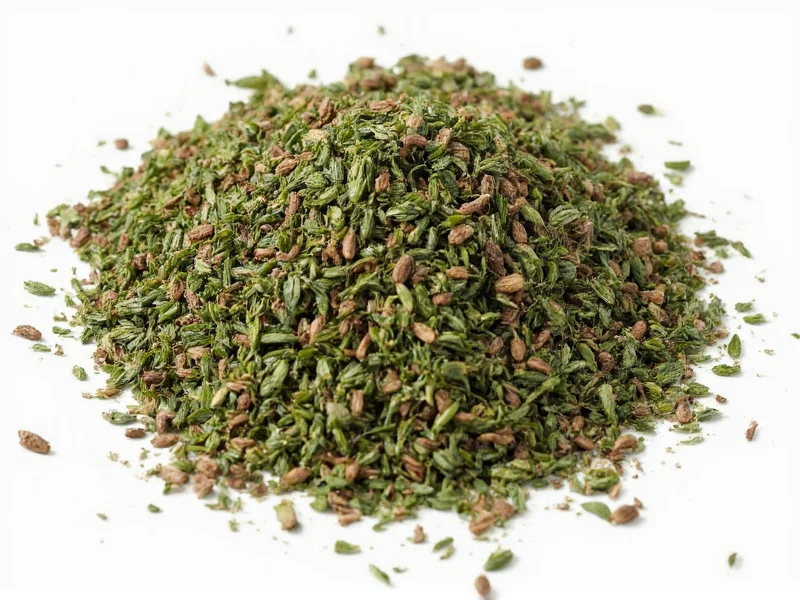Understanding how to properly use crushed thyme can transform your cooking from ordinary to exceptional. This versatile dried herb brings the distinctive earthy, slightly minty flavor of thyme to your dishes with greater intensity than its fresh counterpart. Unlike fresh thyme sprigs that need to be removed before serving, crushed thyme integrates seamlessly into sauces, rubs, and baked goods.
What Exactly Is Crushed Thyme?
Crushed thyme consists of dried thyme leaves that have been mechanically broken down into small particles. The drying process concentrates the essential oils, resulting in a more potent flavor profile compared to fresh thyme. During production, fresh thyme undergoes careful dehydration at controlled temperatures to preserve maximum flavor compounds before being crushed to the desired consistency.
Crushed Thyme vs Fresh Thyme: Key Differences
The primary distinction between crushed thyme and fresh thyme lies in flavor concentration and application. Fresh thyme offers a brighter, more delicate flavor with subtle grassy notes, while crushed thyme delivers a more intense, earthy profile that holds up better in extended cooking processes. The moisture content difference significantly impacts how each form behaves in recipes.
| Characteristic | Crushed Thyme | Fresh Thyme |
|---|---|---|
| Flavor Intensity | 3-4 times stronger | Milder, more delicate |
| Best Cooking Method | Long simmering, baking | Finishing, quick cooking |
| Shelf Life | 1-2 years properly stored | 1-2 weeks refrigerated |
| Texture Integration | Blends completely | Requires removal of stems |
Mastering the Crushed Thyme Substitution Ratio
When converting recipes that call for fresh thyme to use crushed thyme instead, the standard substitution ratio is 1:3. This means for every tablespoon of fresh thyme required, you should use one teaspoon of crushed thyme. This crushed thyme substitution ratio accounts for the concentration of flavor compounds during the drying process.
For precise measurements in baking or delicate sauces, consider using ¾ teaspoon of crushed thyme when a recipe specifies 1 tablespoon of fresh. Always add crushed thyme early in the cooking process to allow its flavors to fully integrate, unlike fresh thyme which often works best when added toward the end of cooking.
Optimal Culinary Applications for Crushed Thyme
Certain dishes particularly benefit from using crushed thyme rather than fresh. The best dishes for crushed thyme include slow-cooked preparations where the herb has time to rehydrate and distribute its flavor evenly. Think hearty beef stews, tomato-based pasta sauces, and roasted root vegetable medleys.
When creating dry rubs for meats, crushed thyme outperforms fresh thyme by adhering better to the protein surface and creating a more consistent flavor profile. For breads and savory baked goods, crushed thyme distributes more evenly through the dough than fresh leaves, ensuring consistent flavor in every bite.
Proper Storage Techniques for Maximum Flavor Retention
Learning how to store dried thyme properly significantly extends its shelf life and preserves flavor. Keep crushed thyme in an airtight container away from direct light, heat, and moisture. A dark cabinet away from your stove provides ideal conditions. Properly stored crushed thyme maintains peak flavor for 12-18 months, though it remains safe to consume indefinitely if kept dry.
Never store crushed thyme in the refrigerator, as humidity causes condensation that degrades quality. To test if your crushed thyme has lost potency, rub a small amount between your fingers and smell it. If the aroma is faint or musty rather than distinctly herbal, it's time to replace your supply.
Flavor Pairing Guidance for Crushed Thyme
Understanding crushed thyme flavor profile helps create balanced dishes. This herb complements other earthy flavors like mushrooms, garlic, and onions while cutting through rich meats like lamb and duck. It works particularly well with lemon zest, creating a bright counterpoint to its inherent earthiness.
When using crushed thyme in Mediterranean cuisine, pair it with oregano and rosemary for authentic flavor profiles. In French cooking, combine it with bay leaf and parsley for classic bouquet garni applications. For unexpected pairings, try crushed thyme with dark chocolate in mole sauces or with honey in glazes for roasted vegetables.
Avoiding Common Crushed Thyme Mistakes
Many home cooks make critical errors when using crushed thyme that diminish its potential. Adding it too late in the cooking process prevents proper flavor integration, while using excessive amounts creates overpowering bitterness. Never substitute whole dried thyme leaves for crushed thyme without adjusting quantities, as the flavor release differs significantly.
When measuring crushed thyme, avoid packing it tightly into measuring spoons as you would brown sugar. Instead, spoon it lightly and level off for accurate measurements. For the most vibrant flavor, toast crushed thyme briefly in a dry pan before adding to recipes, which releases additional aromatic compounds.
Practical Applications Across Cooking Methods
Different cooking techniques require specific approaches to using crushed thyme. For braising meats, incorporate crushed thyme early with other aromatics to build foundational flavor. In salad dressings, mix crushed thyme with vinegar first to help rehydrate and release its oils before adding oil.
When making infused oils, combine crushed thyme with a neutral oil and gently heat to extract maximum flavor without burning the delicate herb. For soups and stews, add crushed thyme during the first half of cooking time to allow complete flavor integration while preserving aromatic qualities.











 浙公网安备
33010002000092号
浙公网安备
33010002000092号 浙B2-20120091-4
浙B2-20120091-4